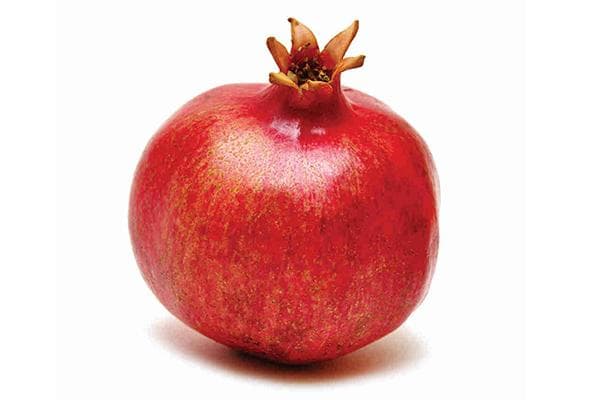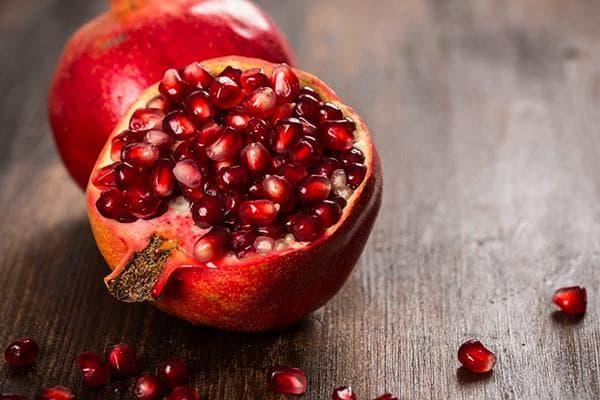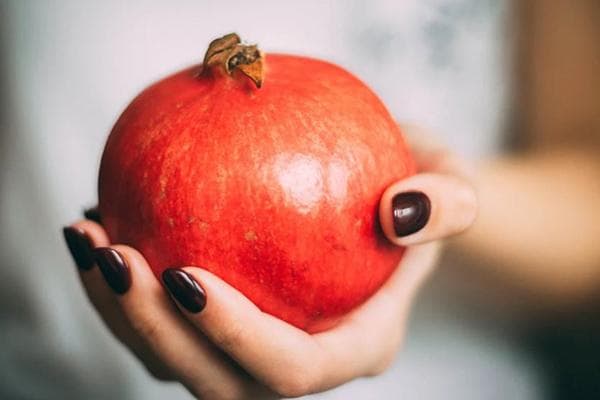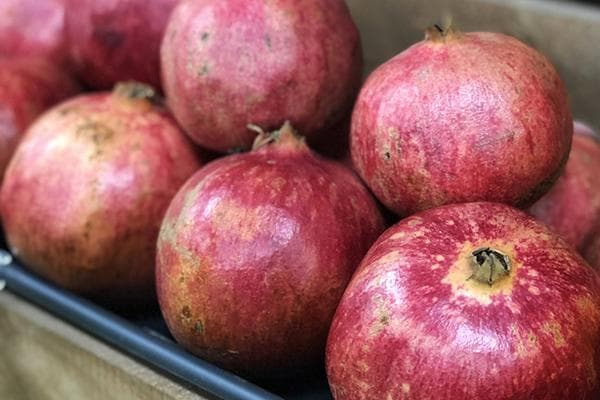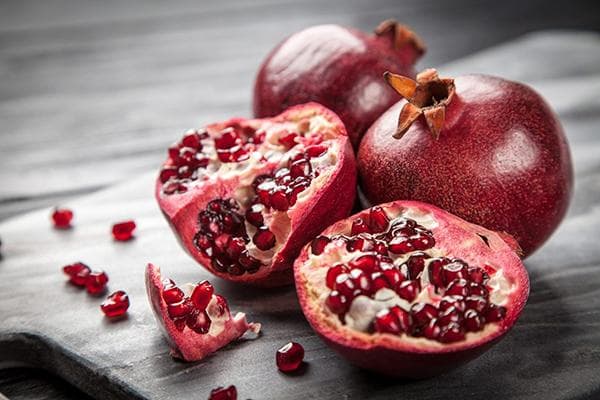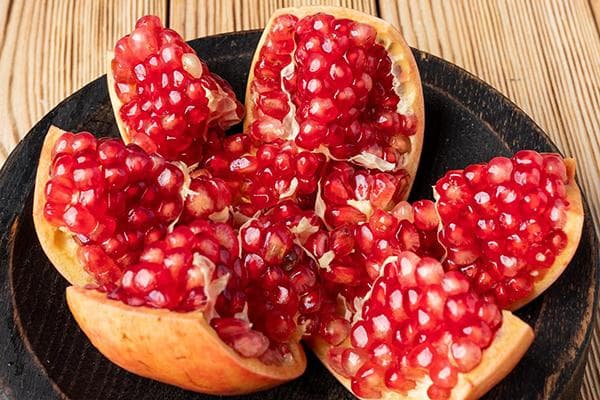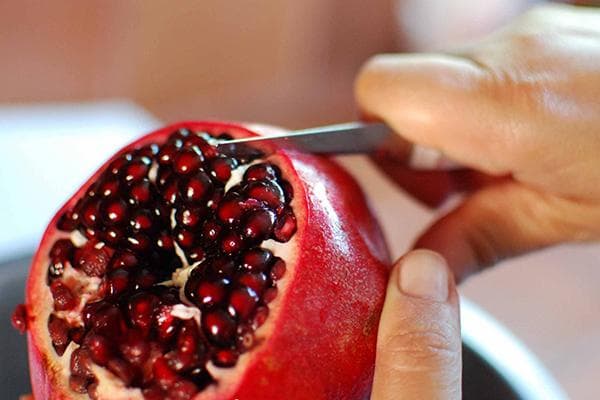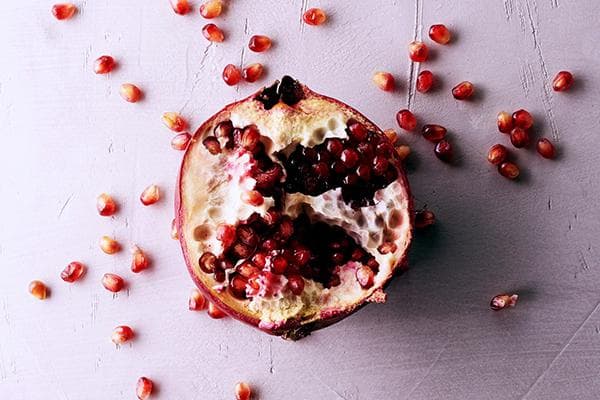3 secrets will help you choose the right ripe and sweet pomegranate
Content:
True gourmets shared their secrets on how to choose pomegranates of breathtaking juiciness and ripeness. The taste of the grains will be determined by the peel, the flower at the base and the total weight of the fruit. Having carefully examined the fruit, you definitely can’t go wrong.
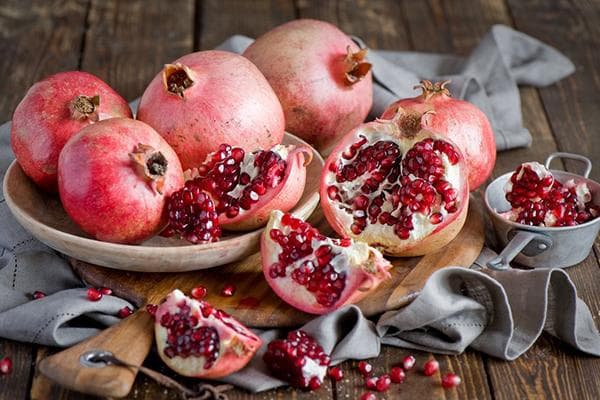
Ripeness test
The most useful pomegranate is a ripe pomegranate. At the peak of ripening, the greatest amount of nutrients and microelements is concentrated in the fruits.
Doctors recommend eating pomegranates for people with diseases of the cardiovascular system and low hemoglobin. The grains contain essential amino acids, vitamin B6, K and many others. They have a positive effect on the functioning of the hematopoietic organs, relieve chronic fatigue and loss of strength.
How to understand that the fruit is healthy and ripe? In a store with a small turnover, sellers often helpfully cut off the “lid”. Like, admire how beautiful the grains are. Unfortunately, spectacular performance does not guarantee juiciness and sweet taste. Rich red grains may turn out to be sickly sour. Pomegranate gourmets advise not to cut the fruit on the spot, but to twirl it a little in your hands.
"Crown" only for the best
The “crown” of a pomegranate is the flower cup.As the fruit ripens, it dries and the petals bend back, forming something like a royal crown.
The more beautiful and drier the tip of the pomegranate, the more likely it is that you have a juicy and ripe specimen.
The flower calyx can also tell you about the condition of the pomegranate seeds. If it is soft, with gray-green patches, there is a high probability that you will find mold and rot inside. Unscrupulous sellers often cut off this part. In this case, you need to pay attention to other signs.
Small and remote
If the selected pomegranate, despite its small size, weighs 400–700 grams or more, you can safely give it a “+”.
The heavier the fruit, the more juice it contains.
Unripe pomegranates, as well as overripe (shrunken) ones, mainly consist of seeds, voids and peel. They have negligible weight. Liquid, ripe juice – that’s what gives the heaviness. If a fruit the size of a man's fist weighs only 200 grams, it is better to leave it on the shelf in the store.
We meet by clothes
The condition of the peel is usually the first thing people pay attention to when choosing a pomegranate. And it is right. In a ripe and juicy fruit it:
- beautiful color: red, burgundy, yellow, pink (depending on the variety);
- matte, not shiny;
- no cracks;
- no dents;
- without gray-brown spots;
- thin but dense.
Good quality thin-barked garnet. The tubercles of grains can be clearly felt under the skin.
Shallow scratches and healed punctures on the skin do not affect anything. But it is better to avoid large cracks. Exposed grains are easily affected by mold fungi. If you damage the fruit on the way home, eat it quickly, otherwise it will disappear.
What else should you pay attention to when buying a pomegranate?
Choosing a pomegranate can be compared to choosing a watermelon.The same approach is often applied to both. Pomegranates are also “tapped” and, first of all, specimens with a dry tip are selected. So, how else can you test fruits for ripeness:
- Tap the pomegranate with your index finger. If the sound is dull, there is a lot of emptiness inside. The juicy fruit sounds loud. You can compare it to the ringing sound of metal.
- Pay attention to the brightness of the color. Pallor of the peel often indicates a large amount of acid. But there are also exceptions to the rules. For example, seedless varieties, which are often light in color.
- If the seller helpfully cut off the “lid”, evaluate the shape of the grains. Ripe and sweet pomegranate seeds are oblong and have a well-defined ribbed surface. A round shape is a sign of immaturity.
- Smell the fruit. Unlike apples, strawberries and peaches, ripe pomegranates do not emit any flavor at all. Unripe fruits smell.
- Press down on the inflorescence. A crunch sound is a good signal. It means that ripe grains crack under pressure.
Sweet and sour pomegranate varieties
There are about 350 varieties of pomegranate. They have different taste qualities, have their own shape and color. Conventionally, all grenades can be divided into two categories:
- stone fruits;
- seedless.
The first group is the most extensive. It is widespread and familiar to everyone. But not everyone has heard of seedless pomegranates. They were bred artificially.
The distinctive feature of seedless pomegranates is their sweet taste. The grains of the fruit are soft, honey-like and not at all sour, even if the fruit is slightly unripe.
Stone fruits
Most pomegranate varieties contain a seed inside the grain. It bothers some people, and they spit it out after eating the juicy pulp.Others eat the grains along with the seeds. In small quantities they are not harmful to health. First of all, pomegranates should be selected according to ripeness. Excessive acid irritates the stomach lining and harms digestion much more than the hard core of grains.
The rich juice of stone fruit pomegranates irritates the stomach lining, and the seeds can cause intestinal upset. Doctors urge limiting their use to people with gastritis, ulcers and other chronic diseases of the digestive system.
Knowing the variety helps determine the sweetness of a fruit in many ways. Most often you can find grenades in the store:
- Ahmar. Iranian pomegranate, which is deservedly considered one of the sweetest. Its juice contains up to 19% sugar. The fruits have a pink-green skin. The grains have a light pink tint.
- Gyuleysha is red. The round fruits with carmine skin are grown in Azerbaijan. The grains are large, rich cherry color. The taste is tart, sweet and sour.
- Ak-Don Crimean. Bred in the Nikitinsky Botanical Garden. The fruit has a thin, cream-colored skin with a blush on one side. The grains are dark pink, sweet with sourness.
- Bala-mursal. The variety was bred in Azerbaijan. He is often compared to the Iranian Ahmar. The fruits contain 16% sugar and taste very sweet. They have a slightly flattened shape and a crimson-red color.
- Achikanor. Round red fruits with cherry-colored grains. The taste is sweet and sour, tart. It is believed that pomegranates of this variety quench thirst better than ayran and kumiss.
- Dogwood anor. Early variety. Cultivated in Uzbekistan. The fruits are of different sizes, with pink skin and red grains. The taste is sweet and sour.
- Dholka. Pomegranates come from India.They have a soft pink color, the grains are pinkish or white. Many give them primacy in sweetness. It is noteworthy that Indians use the fruits to prepare painkillers.
- Mangulati is sweet. Israeli variety. The fruits are round, beautiful pink in color. They have a pleasant sweet taste with barely noticeable sourness.
Seedless
Seedless pomegranates appeared in stores not so long ago and immediately won the sympathy of Russians. Which is not surprising. Seedless pomegranates are always sweet, no matter which fruit you choose. Of course, calling them seedless is not entirely true. Inside the grains there are white inclusions - “binder” (the botanical name of the substance). But they are not felt at all when chewed due to their soft consistency.
Popular seedless varieties:
- Wonderful. A very popular variety in America. It is most often imported to Russia from Egypt. The fruits are distinguished by their white-yellow color. They have blush on one side. The grains are a dull cream color, very sweet and soft.
- Mollar de Elche (Mollar de Elche). The variety is widespread in Spain. The fruits are medium and large, can weigh 800 g or more. The peel is light red, the grains also have a rich red tint. They taste sweet, with soft, edible seeds.
Despite the fact that all seedless varieties have inherent sweetness, you also need to know how to choose pomegranates. They can be sickly sweet, juicy, even watery. When choosing, it is correct to focus on all of the above signs of ripeness, with the exception of one small amendment: Wonderful pomegranates are chosen according to the “lightest” principle. The fruit with a dull skin is always juicier than its ruddy counterparts.
Seedless pomegranates are an ideal option for people with diseases of the digestive tract.
Correctly cut and taste the pomegranate
Having chosen a juicy and ripe pomegranate, hurry to cut it and enjoy the delicious seeds. You can do this in three ways:
- Method number 1. Cut off the top of the pomegranate with the inflorescence to a depth of about 1 cm. Make a cross-shaped cut in the peel. Pierce the core with a thin knife to a depth of 5–10 cm. Now open the pomegranate. In front of you will be 4 neat parts with whole beautiful grains.
- Method number 2. Cut off the top to a depth of 1 cm. Pierce the core. Having gone down 3-4 cm, make a cut on the peel around the circumference. Take it off. Turn the pomegranate over with the exposed seeds facing down over a deep bowl. Tap the peel with the handle of the knife. All the grains fall into the bowl. By the way, this cleaning method is only suitable for very ripe and fresh pomegranates, which literally crack in your hands.
- Method number 3. Cut off the top. Cut the peel crosswise. Pierce the core and place the pomegranate under water. After about 20 minutes, the partitions will swell and the grains will easily detach. Clean the grenade directly under water.
Pomegranate is a very ancient fruit with a rich history. During excavations of Egyptian pyramids, fruits were found in sarcophagi. Scientists believe that the plant appeared 66 million years ago at the end of the Cretaceous period. Just think, once upon a time, tarbosaurs, tyrannosaurs and pterodactyls flew near these fruits. And today everyone can buy a wonderful grenade in the store.
Choosing a ripe pomegranate is easy if you know some of the features of its ripening. Without going into details, indicators of ripeness are heavy weight, dry inflorescence and grains emerging through the skin. Give preference to fruits that have a polyhedron shape, and you definitely won’t go wrong!
